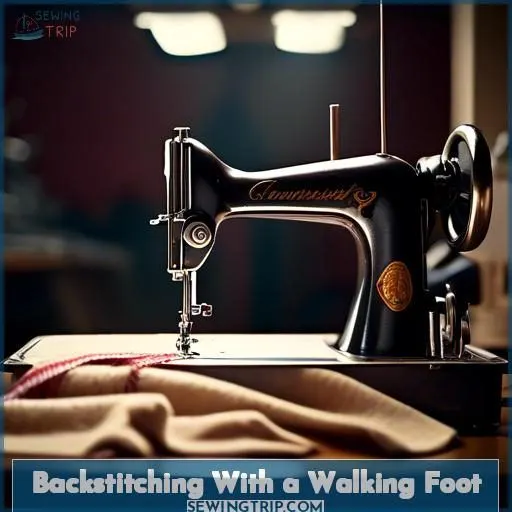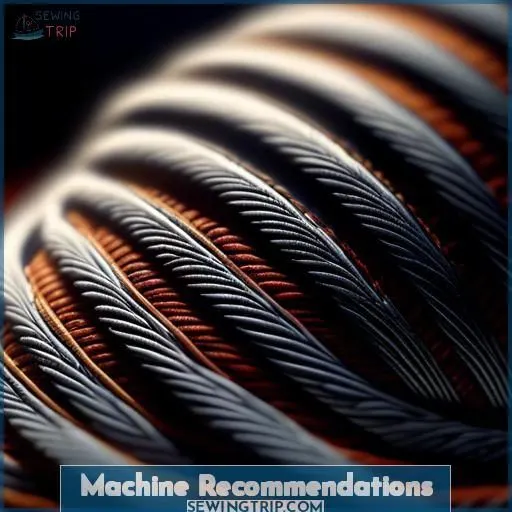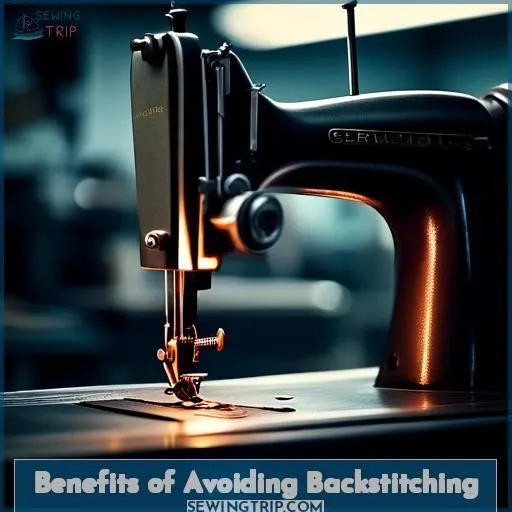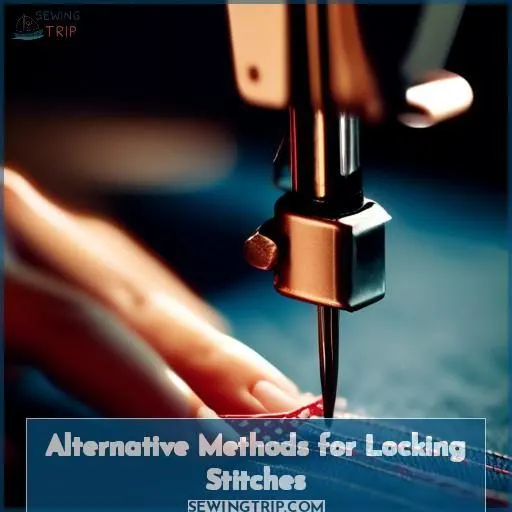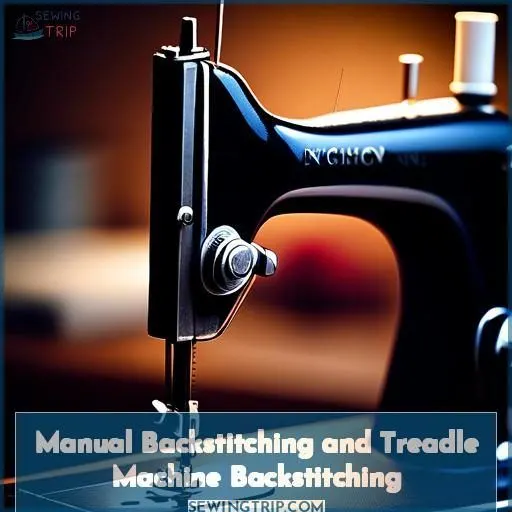This site is supported by our readers. We may earn a commission, at no cost to you, if you purchase through links.
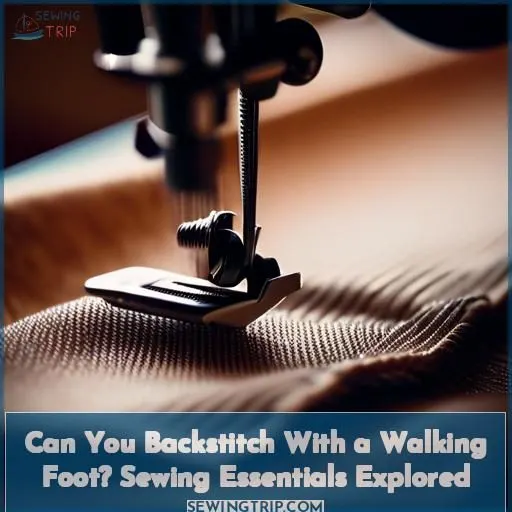
While you can technically backstitch with a walking foot, it’s generally not recommended. Backstitching with a walking foot can cause damage to the foot and lead to uneven stitches or bumps in your project.
Instead, consider alternative locking methods like varying stitch length, using specialty stitch designs, or manually backstitching by lifting the presser foot and reversing the fabric. These techniques can effectively lock your stitches without the risks associated with backstitching with a walking foot.
If you want to learn more about the benefits of avoiding backstitching and explore other locking methods, keep reading.
Table Of Contents
Key Takeaways
- Backstitching with a walking foot can cause damage to the foot and result in uneven stitches or bumps in your project.
- Alternative locking methods, such as varying stitch length, using specialty stitch designs, or manually backstitching by lifting the presser foot and reversing the fabric, are recommended to effectively lock stitches without the risks associated with backstitching with a walking foot.
- Machine compatibility varies, with some walking feet capable of sewing in reverse, while others may risk breakage when reverse stitches are attempted. It’s essential to consult the machine’s manual for specific guidance.
- Employing alternative methods for locking stitches, such as starting with snug stitches and gradually extending their length, using a quilt binding, manually fastening loose threads, or experimenting with different stitch patterns, can secure stitches effectively without needing to backstitch.
Can You Backstitch With a Walking Foot?
Yes, you can backstitch with a walking foot. Most walking feet include a clip-in seam guide, which is helpful when sewing straight lines onto a quilt project. However, some sewing machines may have specific instructions or restrictions regarding backstitching with a walking foot, so it’s crucial to refer to your machine’s manual for guidance.
Backstitching With a Walking Foot
Backstitching with a walking foot can be a challenging task. While certain machines permit it, others advise against it. Backstitching designs can produce noise and potential harm to the walking foot.
Instead, consider securing stitches by starting with close stitches and gradually increasing their length. This approach not only effectively safeguards stitches but also averts bumps and protuberances on the rear of the quilt.
Always consult your machine’s manual for specific recommendations. Some walking feet may not be compatible with reverse sewing, so make sure to inspect the pads for movement in all directions before attempting.
Machine Recommendations
Delving into the realm of sewing, you’ll discover that not all walking foot varieties are equivalent. Certain machines, such as Janome, exhibit unwavering composure during backstitching, whereas others, like Brother, may evoke skepticism. When augmenting with feet, bear in mind that compatibility is paramount, akin to selecting a dance partner for fabrics with variable traction.
And should uncertainty arise, Brother’s customer service, like a sewing oracle, stands ready to impart guidance. Therefore, can one backstitch with a walking foot? It’s akin to inquiring if salsa can be performed in sneakers – feasible, but equipment verification is prudent.
Benefits of Avoiding Backstitching
Avoiding backstitching with your walking foot can provide significant benefits. By locking your stitches effectively and preventing bumps or blobs on the back of your quilt, you’ll improve the overall quality of your quilting while also reducing potential damage to your walking foot.
Backstitching Damage
Backstitching with a walking foot can cause noise and damage to the foot. It may also create bumps and blobs on the back of your quilt. Some machines allow backstitching, while others recommend against it.
If you want to lock your stitches effectively, start with tight stitches and gradually increase length. Alternatively, you can use a quilt binding or tie off loose threads manually.
Always follow your machine’s instructions to avoid potential issues.
Alternative Locking Stitches
After examining the drawbacks of backstitching, let’s investigate the realm of alternate locking stitches. Here are methods to secure your stitches without reversing:
- Begin with stitch length variation; start taut and progressively loosen.
- Experiment with alternate stitch designs that inherently fasten the thread.
- For those preferring manual techniques, manual locking stitches or the traditional elegance of treadle machine locking are viable options.
Walking Foot Compatibility
Regarding walking feet, compatibility with backstitching varies. Some walking feet are capable of sewing in reverse, while others risk breakage when reverse stitches are attempted. Manuals may omit information regarding reverse stitching, and certain machines may not support this function. It’s essential to consult the manual for specific guidance and to verify the foot’s compatibility.
Additionally, heed machine warnings and consider stitch size limitations when sewing in reverse.
Alternative Methods for Locking Stitches
For securing stitches in your quilting endeavor, there are multiple alternatives to backstitching with a walking foot. Here are five options to examine:
- Begin with snug stitches and incrementally extend length: This approach entails starting with a few snug stitches and then gradually increasing the length of your stitches as you proceed with quilting. This can assist in securing the stitches effectively and preventing lumps or blobs on the back of your quilt.
- Employ a quilt binding: Binding the borders of your quilt is a prevalent method for securing the stitches. You can utilize a single or double fold binding, contingent upon the dimensions and requirements of your project. This method provides a pristine and polished finish and can be particularly advantageous for projects with curved or scalloped borders.
- Manually fasten loose threads: If you have some loose threads that warrant securing, you can fasten them manually prior to or after quilting. This method can be time-consuming but can assist in obviating the need for backstitching.
- Contemplate using a distinct stitch pattern: Depending on the particular machine and project, you may discover that a distinct stitch pattern is more suitable for securing stitches. Experiment with various patterns to ascertain what’s most effective for your situation.
- Experiment with diverse techniques: Quilting is an art, and there are numerous avenues to attain the desired outcomes. Don’t hesitate to attempt diverse techniques and ascertain what’s most suitable for you and your project.
Manual Backstitching and Treadle Machine Backstitching
Regarding backstitching with a walking foot, contemplating manual backstitching and treadle machine backstitching is prudent. Manual backstitching entails raising the presser foot, inverting the fabric, and sewing 2-3 stitches before reiterating the procedure. This method is laborious but can be efficacious for securing stitches**.
Treadle machine backstitching, conversely, obviates the need for a back stitch capability. Instead, one would elevate the presser foot, reverse the fabric, and stitch as customary.
If unsure about backstitching with a particular machine, it is imperative to adhere to the manufacturer’s guidance and seek counsel from a seasoned quilter or machine specialist.
Frequently Asked Questions (FAQs)
Can I backstitch with a Janome walking foot?
With your Janome walking foot, you can backstitch to your heart’s content without a single hiccup. The walking foot will handle those reverse stitches like a champ, so stitch away fearlessly!
How do I lock stitches without backstitching?
Instead of backstitching, start with tight stitches and gradually increase the length. This secures the seam without causing bumps or damaging your walking foot. Give it a try – your quilting will look smoother!
What are the risks of backstitching with a Brother walking foot?
According to Brother, backstitching with their walking foot can cause noise and potentially damage the delicate mechanism. It’s best to avoid this practice for ideal performance and extended lifespan of your machine.
Can I use an add-on walking foot for backstitching?
Ah, good question! With an add-on walking foot, you’ll want to check the manufacturer’s recommendations. Some may allow a bit of backstitching, while others caution against it. Best to play it safe and follow their guidance.
What are the benefits of using a different stitch pattern for locking?
Different stitch patterns can lock stitches more effectively than backstitching. You’ll avoid bumpy seams and potential damage to your walking foot. Try experimenting to find the locking technique that works best for your project and machine.
Conclusion
Ultimately, while you can technically backstitch with a walking foot, it’s generally not recommended. As we’ve explored, backstitching with a walking foot can damage the foot and lead to uneven stitches or bumps in your project.
Instead, consider alternative locking methods like varying stitch length, using specialty stitch designs, or manually backstitching by lifting the presser foot and reversing the fabric. These techniques can effectively lock your stitches without the risks associated with backstitching with a walking foot.

